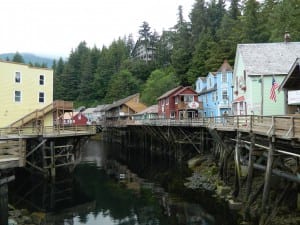
The Ketchikan Gateway Borough contracted with the McDowell Group and partner Millard + Associates to prepare a Comprehensive Housing Assessment Project. The study looked at the Ketchikan housing market, vacancy rates, costs, affordability, and economic trends. A presentation on the report was given at a recent Ketchikan Chamber of Commerce luncheon.
The study was published in January. Borough Planning Director Richard Harney gave an overview of the assessment and how the information might be used. Data was gathered from interviews, census statistics, borough statistics, the assessor’s database, and records of building permits over the past seven years.
Harney says the majority of housing units, about 61 percent, are older, single-family homes.
He says single-family homes are found throughout the borough, but most multi-units, such as duplexes, townhouses and condos, are located within city limits, largely because of access to public water and sewer.
“We do have some housing complexes that are going in on the south end of town now. Once again, we have public water and sewer that has been put in, and it’s pretty well-maintained out there.”

Harney says there are not many rentals available. He says vacancy rate studies by the Alaska Housing Finance Corporation are done in March, which does not reflect the effect of seasonal housing needs. Outside of summer, the vacancy rate is 11 percent, with a shortage of housing during the tourist season. Harney says vacation rentals also may be limiting housing availability.
“People are buying homes, single families, and they’re renting them out. They’re keeping them vacant during the winter time. They’re keeping them vacant so they can have it for their own vacation rental. That’s our speculation. That’s what we’re seeing as a national trend. We’re assuming that it’s very similar here in Ketchikan.”
Harney says some communities in the Lower 48 have put regulations on vacation rentals. Though there are no regulations planned in the Ketchikan Gateway Borough at this time, Harney says it’s something to consider.
“About eight years ago, we did have a public meeting on that and it was pretty unanimous that, ‘No, we’re not going to even deal with that.’ It might be time to revisit that conversation.”
Harney says median household income in Ketchikan is about $67,000, but to afford the average sale price of a single family home, an annual income of between $80,000 and $90,000 is needed.
“We’re not there. That’s part of the problem. The incomes are too low for how high our home values are.”
Harney says there is a gap in single-family home prices causing a low-income housing shortage. He says, in general, someone with a good-paying job can afford a house in the $150,000 to $300,000 range, but few are available. Harney says most end up renting rather than buying.
“But we believe that if that middle income gap, that workforce housing area, were to be able to be filled and people that are living in the lower income housing – the apartments, the rentals – and they were able to afford to buy homes, we think that would create some margin in the low-income housing, in the rentals, because they just can’t make the jump all the way to the $400,000 / $425,000 homes.”
Harney says it is not attractive to contractors to build $300,000 homes in Ketchikan, because the cost to build can be more than the value. He says other challenges include lack of accessible flat land, access to sewer and water, and the cost of materials and freight.
He says the planning department is exploring how to make borough land available that is affordable and cost-effective to developers. Harney says they are also looking at possible public-private partnerships, and changing zoning to allow for smaller residential lots.
Harney sees the next step as setting up a housing commission or committee to set goals and identify which issues to address first. He says a community has to have adequate, affordable housing in order to have a diverse economy and workforce.
He says the assessment is the first step in increasing awareness and getting ideas for solutions from the community.





